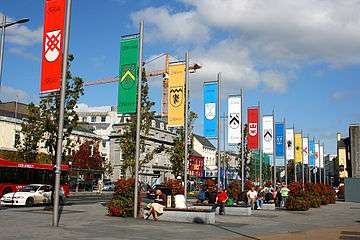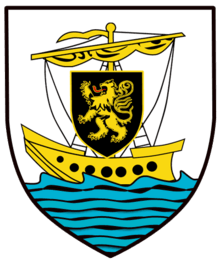Tribes of Galway
The Tribes of Galway (Irish: Treibheanna na Gaillimhe) were 14 merchant families who dominated the political, commercial and social life of the city of Galway in western Ireland between the mid-13th and late 19th centuries. They were the families of Athy, Blake, Bodkin, Browne, D'Arcy, Deane, Font, Ffrench, Joyce, Kirwan, Lynch, Martin, Morris and Skerritt. Of the 14 families, 12 were of Anglo Norman origin, while two — the D'Arcy (Ó Dorchaidhe) and Kirwan (Ó Ciardhubháin) families — were Normanised Irish Gaels.

History
The Tribes were merchant families who prospered from trade with continental Europe. They dominated Galway's municipal government during the medieval and early modern eras.
The Tribes distinguished themselves from the Gaelic peoples who lived in the hinterland of the city. Many of these families spoke Irish as a second or even first language. However, the feared suppression of their common faith joined both groups together as Irish Catholics after the Irish Rebellion of 1641. During the Irish Confederate Wars (1641–1653), Galway took the side of the Confederate Catholics. Following the Cromwellian conquest of Ireland, the English government punished the Tribes. Galway was besieged and after it surrendered in April 1652, the Tribes had to face the confiscation of their property by the New Model Army.
The Tribes lost much of their power within Galway city after English Parliamentarians took over the Galway Corporation in 1654. Cromwell's forces referred to them by the derogatory name, "The Tribes of Galway", which the families later adopted as a mark of defiance.[1]
Galway's urban elite gained a restoration of some of their power during the reign of the King Charles II (1660–1685) and his successor James II. However, Jacobite defeat in the War of the Two Kings (1689–91), marked the end of the Tribes' once overwhelming political influence on the life of the city. Power passed to the small Protestant population. Garrison members of the Tribes who owned land in Galway and Mayo were protected by the advantageous surrender provisions that were signed on 22 July 1691.
Notable members
Athy
- Margaret Athy (fl. 1508), founder of the Augustinian Friary of Forthill
Blake
- John Blake fitz William, third Mayor of Galway, 1487–1488
- Captain James "Spanish" Blake, fl. 1588–1635, spy and purported assassin of Red Hugh O'Donnell
- Joaquín Blake y Joyes, (1759–1827), Spanish military officer who served with distinction in the French Revolutionary and Peninsular wars
- Sally Blake, landowner and duelist, 1774–1870
Bodkin
- John Bodkin fitz Richard, Mayor of Galway, 1518–19
- Dominick Dáll Bodkin, mass murderer, executed 8 October 1740
- Manuel Antonio Flórez Maldonado Martínez Ángulo y Bodquín, admiral in the Spanish navy and viceroy of New Granada (1776 – 1781) and New Spain (1787 – 1789).
- John Bodkin (died 1710), Roman Catholic Warden of Galway. After his death, his body was said to have been the subject of a miracle because it was thought to have not decayed
- Leo Bodkin (1879 – 30 August 1919), British military officer and writer
- Michael Bodkin (c.1888–1900), inspiration for Michael Furey in James Joyce's short story "The Dead"
Browne
- Geoffrey Browne (died 1668), Irish Confederate lawyer and politician
- Mary Bonaventure Browne (before 1610 – after 1670), Poor Clare and historian,
- John Browne, 1st Marquess of Sligo
- Garech Browne (1939-2018), patron of Irish arts and one-time manager of The Chieftains
D'Arcy (Ó Dorchaidhe)
- Walter Riabhach Ó Dorchaidhe, founder of the merchant family
- James Riabhach Darcy, Mayor of Galway, 1602–1603.
- Patrick D'Arcy (1598–1668), Catholic Confederate and lawyer who wrote the constitution of Confederate Ireland
- Patrick d'Arcy (1725–1779), mathematician and soldier
Deane
- Edmond Deane, 18th Mayor of Galway, 1502–1504
Font (ffont)
- Geoffrey Font (1709–1814), centenarian
French (ffrench)
- Christopher French, (fl. c. 1650-c.1713), theologian
- Sir Oliver Óg French (died 1666), Irish nationalist
- Seán an tSalainn French (1489–1546), Mayor of Galway, 1538–1539
- Arthur French, 1st Baron de Freyne
- Patricio French (b. 1742-?) Spanish nobleman, merchant and politician
- Conrad O'Brien-Ffrench (1893–1986), artist and secret agent,
Joyce
- Henry Joyce, Mayor of Galway, 1542–1543
- Richard Joyce (c. 1660 – c. 1737), creator of the Claddagh Ring
- Patrick Weston Joyce (1827 – November 1914) historian, writer, and music collector
Kirwan (Ó Ciardhubháin)
- William Ó Ciardhubháin, founder of the merchant family
- Dominick Kirwin (fl. 1642–1653?), Irish Confederate
- Joseph W. Kirwan (1796–1849), first president of Queen's College, Galway
- Magdalen Kirwan (c.1830–1906), Sister of Mercy and manager of St. Vincent's Industrial School, Goldenbridge
- Richard Kirwan (1733–1812), president of the Royal Irish Academy
- Risteárd Buidhe Kirwan (1708–1779), soldier and duellist
- Sarah Annette Kirwan (d. 1913), first wife of Sir Edward Carson, Ulster Unionist leader
- Laurence P. Kirwan (1907-1999), KCMG, Egyptologist and archeologist; head of Royal Geographical Society[2]
Lynch
- Anthony Lynch (c. 1576-after 1636), Dominican and Barbary captive
- Christopher Lynch (fl. 1601–1604), Mayor of Galway
- Dominick Dubh Lynch (died 1508), second Mayor of Galway
- Germyn Lynch (fl. 1441–1483), merchant and entrepreneur
- Isidore Lynch (1755–1841), soldier
- Jean-Baptiste Lynch (1749–1835), Mayor of Bordeaux and a peer of France
- John Lynch (1599?–1677?), historian and Archdeacon of Tuam
- Maire Lynch (fl. 1547), Countess of Clanricarde
- Patrick Lynch (Argentina) {1715-1789) ancestor of Che Guevara
- Thomas Kerr Lynch (1818–91), explorer
Martin (Ó Máirtín)
- Edward Martyn (1859–1923), political and cultural activist
- Francis Martin (1652–1722), Augustinian priest
- Mary Gabriel Martyn (1604–1672), abbess of the Poor Clares of Galway.
- Mary Letitia Martin (1815–1850), writer
- Peter Martin (STP) (died 1645), preacher
- Richard Martin (1754–1834), founder of The Society for the Prevention of Cruelty to Animals.
- Richard Óg Martyn (c. 1602–1648), member of the Catholic Confederates of Ireland
- Violet Florence Martin, (1862–1915), author
- William Óg Martyn (fl. 1566–1592), Sheriff and Mayor of Galway
Morris
- Andrew Morris, Mayor of Galway, 1588–1589
- Lieutenant-Colonel Hon. George Henry Morris, 1872–1914, commanding officer of the Irish Guards
- Lord Killanin (1914–99), sixth president of the International Olympic Committee 1972–80
- Redmond Morris, 4th Baron Killanin (born 1947), filmmaker
- Mouse Morris (born 1951), racehorse trainer and former jockey
Skerrett
- John Skerrett (c.1620–c.1688), preacher and missionary
- Nicholas Skerrett (died 1583), archbishop of Tuam
Nickname
Like all Irish counties Galway has a nickname. The nickname the tribesmen is now used for the county and its people and is derived from this term.
Roundabouts
The tribes also lend their names to 14 of the city's roundabouts located in or around the city's boundaries. The roundabouts are signposted on navy blue signs containing the tribe's name in the Irish language.
See Also
References
- Hardiman 1820, pp. 6-7.
- Staff, Guardian (21 April 1999). "Sir Laurence Kirwan". Theguardian.com. Retrieved 11 May 2019.
Bibliography
- "History of Galway", James Hardiman, Galway, 1820.
- Old Galway, Maureen Donovan O'Sullivan, 1942.
- Henry, William, Role of Honour:The Mayors of Galway City 1485–2001Galway, 2002. ISBN 0-906312-50-7
- Martyn, Adrian, The Tribes of Galway:1124–1642, Galway, 2016. ISBN 978-0-9955025-0-5
External links
- "Holdings: The tribes of Galway". Sources.nli.ie. Retrieved 1 October 2017.
- "Tribes of Galway Tribes Galway Ireland". Galway-ireland.ie. Retrieved 1 October 2017.
- "Landed Estates Database". Landedestates.ie. Retrieved 1 October 2017.
- "Athy". Landedestates.ie. Retrieved 1 October 2017.
- "Blake (Annaghdown)". Landedestates.ie. Retrieved 1 October 2017.
- "Bodkin (Annagh)". Landedestates.ie. Retrieved 1 October 2017.
- "D'Arcy (Kiltullagh & Clifden Castle)". Landedestates.ie. Retrieved 1 October 2017.
- "List of Charts from Ireland for the French family Association". Frenchfamilyassoc.com. Retrieved 1 October 2017.
- Administrator. "Home". Martinhistory.net. Retrieved 1 October 2017.
